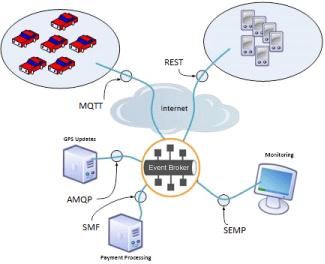Why Solace Support for AMQP 1.0?
Message routing is often required between entities who use different transports and protocols for sending and receiving messages. In many such environments, one can frequently find AMQP being used in applications like back-end server messaging to event brokers. In these sort of multi-protocol environments, an event broker can be used to direct messages back and forth amongst the messaging entities using the transports and protocols the entities use. There isn't a need for multiple messaging brokers to handle the different types of messaging applications.
Connected Vehicle Applications in a Multi-Protocol Environment

The diagram above shows a simple example of a multi-protocol environment where different entities, making use of different protocols, are exchanging messages.
In this example, each car periodically connects through MQTT to the event broker through the Internet and publishes information, such as its location, to be centrally monitored so that it can be found in the case of theft. At the same time, individual car owners may query this information through their mobile devices, using REST from their browser, asking such questions as “Where did I park my car today?”. Access Control List (ACL) rules on the event broker ensure that each mobile device only accesses status published by their owner's car.
Also, each car's GPS can receive updates to its maps. The servers originating GPS updates are directly attached to the event broker and use an AMQP interface to allow the use features not offered by MQTT, such as publishing real-time traffic updates with assured-delivery and a TTL so that the latest information is available to a car when it elects to connect, yet time out and disappear from the car’s queue once out-of-date.